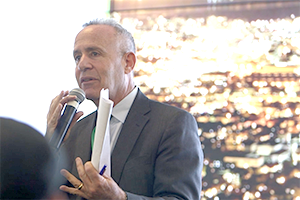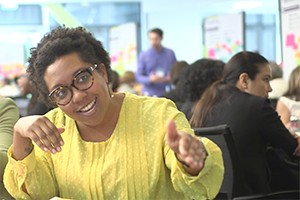More than 300 participants attended “Innovate for Impact: Improving Access to High Quality Mental Health Care,” a one-day workshop earlier this year at Verily Life Sciences in South San Francisco to explore how innovation and technology could improve mental health care in California. The workshop was organized by the California Mental Health Services Oversight and Accountability Commission and multiple partners to encourage mental health consumers, stakeholders and providers, county officials and private sector partners to think in new ways about serving clients.
The Commission was created when voters in 2004 passed Proposition 63, the Mental Health Services Act. The Commission’s mandates includes working with counties to make the best use of about $100 million dedicated each year to new or adaptive approaches in community mental health, including the use of technology.
“Today is a day where people in leadership roles in areas you wouldn’t expect are coming together to help support and solve and take advantage of the technology that has benefitted so many sectors and actually have it benefit mental health,” said John Boyd, chair of the state Commission and CEO of Sutter Health’s Mental Health Services.
 Sacramento Mayor Darrell Steinberg, who authored Proposition 63 and championed it with voters, set the stage for participants: “Innovation, by definition, means don’t circumscribe or limit what we can or should do. Let’s experiment and see what works.”
Sacramento Mayor Darrell Steinberg, who authored Proposition 63 and championed it with voters, set the stage for participants: “Innovation, by definition, means don’t circumscribe or limit what we can or should do. Let’s experiment and see what works.”
Andrew Evans, a design lead from IDEO and summit facilitator, called it a “mindset shift.” He lead participants through brainstorming sessions, discussions and exercises to create new ways of thinking about how to better serve and provide services to people with mental health needs.
Evans said the process can be more effective than day-to-day problem solving: “If you are spending every hour of every day in this context with people with incredible needs, it’s just so easy to have a focused lens. So we’re trying to pivot a little bit and say there’s a different way of asking these questions that might lead to different answers.”
 The discussion groups were intentionally mixed: consumers and other stakeholders, elected and county officials, providers and representatives from the tech industry. They worked together to identify and understand the behaviors and needs of someone with mental health needs. They then brainstormed and designed atypical solutions. One fresh idea, for instance, was whether music streaming services could use algorithms to identify listeners who may be depressed based on their music selection.
The discussion groups were intentionally mixed: consumers and other stakeholders, elected and county officials, providers and representatives from the tech industry. They worked together to identify and understand the behaviors and needs of someone with mental health needs. They then brainstormed and designed atypical solutions. One fresh idea, for instance, was whether music streaming services could use algorithms to identify listeners who may be depressed based on their music selection.
Robin Roberts, the Director of Behavioral Health for Mono County, welcomed different perspectives applied to her everyday challenges.
“I am really excited that we are creating spaces like this conference to have conversations with people who normally wouldn’t ever talk to one another, because we have very different systems and we don’t necessarily work in the same rooms.”
She meets with her peers monthly, but this summit “means that there are people at the table who have very different experiences and we’re trying to sort out a way of looking at a person in a scenario that we’re all going to approach in different ways.”
Austin Heyworth, public affairs manager at Uber, was one of those with a different and new perspective:
“I see how there is definitely interest in getting involved in the healthcare field. With social media being what it is today, there are opportunities to connect people with resources, connecting with other people to be able to help others,” Heyworth said.
“Uber has a community of users in which there’s obviously the ability to help folks in a way that may not be your traditional solution. As the world is changing, so is the way we can tackle some of those issues.”
But new technology was just one of the changing dynamics that encouraged participants to seek new connections and opportunities. Calla Peltier-Olson is a youth organizer for the Humboldt County Transition-Age Youth Collaboration. She is also transgender.
“I think there are structural innovations that would potentially help young people like myself and the young people who I support around deviating traditional mental health practice,” Peltier-Olson said. “Because the lived-experienced movement, as we’ve been saying, this all has to come from our communities. And to me a really innovated practice would be to find that research so we can have a community-based LGBTQ evidenced-based practice – something that’s never been done before or to have evidence and research that supports native spiritual practices to be billable and legitimate.”
The Commission’s vice chair, Khatera Aslami-Tamplen, added: “One of the highlights for me was the courage of the consumers, the individuals with lived experience, who came up and shared that they have struggles with mental health challenges, and also shared what their ideas were about, and spoke up about innovative ways to transform the mental health system.”
The day ended with an accountability challenge to participants to make sure they are working toward creating and implementing positive actions in their communities.
Read our entire series on innovation in mental health services
Part 1: Tech Industry and Mental Health Advocates Seek Solutions at First-Ever Summit
Part 2: County and Tech Innovators Are Rethinking California’s Mental Health Services
Part 3: Can California’s Techies Move the Needle on Mental Health?

